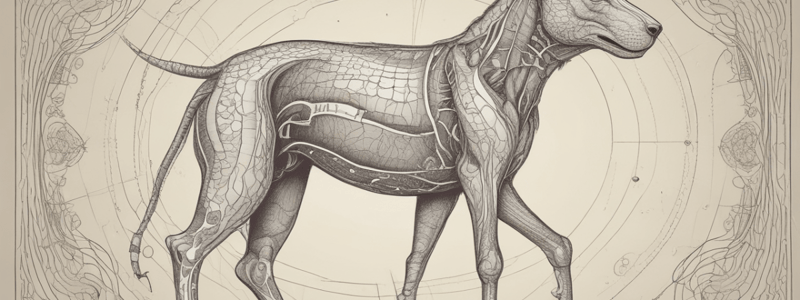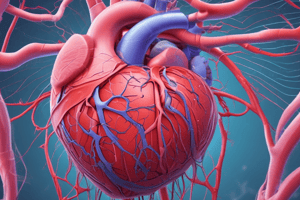Podcast
Questions and Answers
What type of receptors provide information about internal organs?
What type of receptors provide information about internal organs?
- Somatic receptors
- Visceral receptors (correct)
- Cranial receptors
- Spinal receptors
What type of regulation is provided by the autonomic nervous system?
What type of regulation is provided by the autonomic nervous system?
- Motor regulation
- Involuntary regulation (correct)
- Sensory regulation
- Voluntary regulation
What type of information is provided by somatic receptors and sensory neurons?
What type of information is provided by somatic receptors and sensory neurons?
- Information about smooth muscle contractions
- Information about cardiac muscle contractions
- Information about internal organs
- Information about position, touch, pressure, pain, and temperature (correct)
What is the main difference between afferent and efferent?
What is the main difference between afferent and efferent?
What type of neurons are involved in providing information about internal organs?
What type of neurons are involved in providing information about internal organs?
What is sytem is responsible for flight or flight?
What is sytem is responsible for flight or flight?
What is the main objective of the Hands-off system?
What is the main objective of the Hands-off system?
What type of reactions are involved in the Hands-on system?
What type of reactions are involved in the Hands-on system?
What is the term for the sensation of pain?
What is the term for the sensation of pain?
What is the main objective of a neurological examination?
What is the main objective of a neurological examination?
What are the two major subdivisions of the mammalian nervous system?
What are the two major subdivisions of the mammalian nervous system?
What is the function of sensory neurons?
What is the function of sensory neurons?
What is protected by the armor skull and vertebrae?
What is protected by the armor skull and vertebrae?
What is the function of motor neurons?
What is the function of motor neurons?
What is the function of the peripheral nervous system (PNS)?
What is the function of the peripheral nervous system (PNS)?
What is the central nervous system (CNS) composed of?
What is the central nervous system (CNS) composed of?
What is the function of afferent neurons?
What is the function of afferent neurons?
What is the function of efferent neurons?
What is the function of efferent neurons?
What is NOT a subdivision of the peripheral nervous system?
What is NOT a subdivision of the peripheral nervous system?
Study Notes
The Mammalian Nervous System
- The mammalian nervous system has 2 major subdivisions: Central Nervous System (CNS) and Peripheral Nervous System (PNS)
Central Nervous System (CNS)
- Comprises the brain and spinal cord
- Protected by armor-like skull and vertebrae
Peripheral Nervous System (PNS)
- Consists of receptors, nerves, and ganglia
- Connects the CNS to limbs and organs
Sensory Neurons
- Receives and processes sensory information
- Initiates responses, stores memories, and generates thoughts and emotions
- Brings information to the CNS from receptors in peripheral tissues and organs
Motor Neurons
- Carries motor commands from the CNS to peripheral tissues and systems
- Conducts signals to and from the brain, controlling reflex activities
- Controls skeletal muscle contractions (voluntary control)
Neurological Examination
- Main objective: to understand the patient's problem and locate the lesion
- Hands-off examination: assesses level of consciousness, content of consciousness, posture, and gait
- Hands-on examination: assesses cranial nerves, postural reactions, spinal nerves, and nociception (sensitivity to painful stimuli)
Key Terms
- Afferent: relates to sensory neurons
- Efferent: relates to motor neurons
Studying That Suits You
Use AI to generate personalized quizzes and flashcards to suit your learning preferences.
Related Documents
Description
Learn about the central and peripheral nervous systems, neurological examination, and neurolocalizations in mammals.




